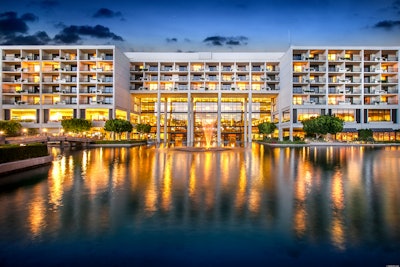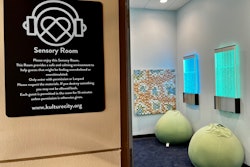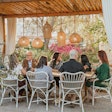
Inclusivity and accessibility are big buzzwords in the event and hospitality industry right now—but what does it really mean to invest in the practice? As we enter Autism Awareness Month, one way to be more inclusive is to acknowledge the needs of neurodivergent event attendees and travelers.
“One in 6 people have a sensory need or sensitivity, and 1 in 36 kids are diagnosed with autism—so this is a huge portion of the population that has not had their needs met,” said Meredith Tekin, president of the International Board of Credentialing and Continuing Education Standards (IBCCES), a global leader in training and certification for professionals who work with autistic individuals and those with other cognitive disorders.
To help, IBCCES offers a Certified Autism Center designation, which is growing increasingly popular among event venues, hotels, and destinations. We asked Tekin and some of those destinations to tell us more.
Why does a certification like this matter?
“Travelers are looking for places to go that are inclusive and accessible, and relatively small changes such as better/more detailed communication, flexible options, and knowledgeable staff make a huge impact on ensuring a positive visitor experience—and can literally change people's lives by enabling them to have these experiences," explained Tekin.
One organization that recently earned the designation is Visit Anaheim—making it one of the first three DMOs in California to complete the training. To Sue O’Shea, Visit Anaheim’s senior director of marketing, the effort and collaboration with IBCCES was all about becoming more aware of the needs of visitors and meeting and convention attendees. “By obtaining this certification, we are able to demonstrate commitment to inclusivity and accessibility in our destination,” she explained. “Additionally, we want to serve as a role model to our community and tourism partners and encourage them to also become certified.”
Meanwhile, JW Marriott Desert Springs Resort & Spa, located in California’s Palm Desert, recently became the first JW Marriott property to become a Certified Autism Center via the IBCCES program. The hotel now supplies things like sensory kits with weighted blankets, sound machines, and fidget toys to guests who may need the support; it can also provide a map outlining low-sensory areas on the property that guests can escape to for a less stimulating experience.
“At JW Marriott, our business is about taking care of people—it’s what we do,” said the hotel’s general manager, Nusrat Mirza, who also recently appeared in a video from Greater Palm Springs about the city's inclusivity efforts. “We want to make sure we are taking care of every guest. Becoming a Certified Autism Destination signifies the brand’s dedicated commitment to inclusivity, accessibility, and support for individuals with autism within our communities.”
How exactly does it work?
The IBCCES certification requires that at least 80% of public-facing staffers complete training, which is provided at different levels based on the person's role. “The focus of the training is how to understand autism and sensory needs and the breadth of those lived experiences, as well as practical guidance on ways to provide accommodations, communicate, and ensure guest safety,” noted Tekin.
Tekin's team also provides on-site reviews, which result in a road map of other processes and accommodations that can be implemented over time to further enhance the experience, along with detailed sensory guides. “Since every person on the spectrum is different, tools like sensory guides allow visitors to prepare their expectations prior to their visit and choose their own adventure according to their particular needs, interests, or triggers,” she said.
Most organizations complete the certification process within 60 days, Tekin added. “We also provide ongoing support and advice for the lifetime of the credential, as well as a required renewal process, to ensure the locations can maintain knowledge levels and have access to experts along the way.”
For Visit Anaheim, 100% of staffers decided to complete the virtual training—meaning they all individually became Certified Autism Travel Professionals too. “The virtual training included a comprehensive study on autism awareness, understanding ASD behaviors, effective communication strategies, and best practices for providing support and accommodations,” said O’Shea. Her ultimate goal? For the entire city of Anaheim to become a Certified Autism Destination.
Mirza notes that the JW Marriott Desert Springs team was also excited and motivated to complete the training. “People want to be thoughtful and inclusive, and they want to learn and educate themselves—so this certification has been a great opportunity," he said.
What should other venues and organizations keep in mind?
Whether you're ready to attain a formal certification or just want to better accommodate neurodivergent travelers, remember that a one-size-fits-all approach doesn't always work.
“Our approach is rooted in compassion and understanding that autism doesn't adhere to a single template,” Mirza explained. “From tranquil indoor and outdoor spaces designed for low-sensory experiences to an array of thoughtful resources such as sensory kits, sound machines, weighted blankets, headphones, and fidget toys, we empower our guests to personalize their stay according to their specific requirements.”
O’Shea encouraged other DMOs and destinations to look into comprehensive training through programs like IBCCES. She also offered some additional advice:
- Consider the environment.
“Encourage your partners to make adjustments to their facilities to create a sensory-friendly environment,” O'Shea suggested. “This may involve providing quiet spaces and offering sensory-friendly materials or resources.” - Clearly communicate.
“Utilize your website and other communication tools to help individuals understand what to expect during their visit (such as strobe lights or loud sound on theme park attractions) and navigate the environment effectively." - Offer a range of accommodations.
“This may include sensory-friendly rooms, access to special dietary options, and assistance with queuing or waiting in lines.” - Ask for input.
“Actively seek feedback from autism/neurodivergent subject matter experts, organizations like IBCCES, and individual travelers and their families about their experiences and how you can improve your services and accommodations," said O'Shea. "Use this feedback to continuously adapt and enhance your offerings to better meet the needs of this demographic.” - Spotlight your efforts!
“Demonstrate your commitment to inclusivity and accessibility in your marketing materials, social media, and website. Highlight the accommodations and support services available in your destination to encourage their participation and engagement with your destination," she said.
Tekin acknowledged that getting started is typically the most daunting step of a process like this—and added that IBCCES regularly provides free education at industry conferences, on social media, and on AutismTravel.com. “It can seem daunting at first to take on accessibility as an initiative,” she said. “That's why when we work with an organization, we provide so much ongoing support and structure to help them along the way.”



















